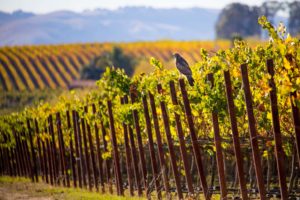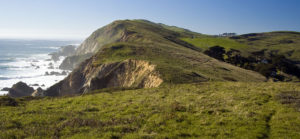Picture the geography of the Bay Area: the sweep of the Bay from the Delta to the Golden Gate; the rolling hills, rugged mountains, and intimate valleys; all the open spaces that frame our communities. The urban landscapes of iconic bridges and landmark buildings, the cities and towns where we live and work, densely packed around the Bay and then radiating into a suburban patchwork beyond.
Now try to put farmland into this picture. That might not be so easy. Many people think of farmlands primarily as passive landscapes–part of non-urban open space–rather than as active working landscapes that contribute directly to local economies, healthful diets, and sense of place. But Bay Area farms and rangelands cover 1.87 million acres, comprising around 40 percent of the region’s total land area, and produce almost enough food to feed all Bay Area residents. In farmers’ markets now spread throughout the region, dazzling arrays of farm products bring a taste of the countryside right into our communities. But the standard measure of “localness” in food is more often a conceptual mileage number than a real connection with the places and people at the core of our incredibly productive local foodshed.
- Muang Saechao picks strawberries that she and her husband farm at Iu-Mien Village Farms in the Sunol AgPark. Photo by Stephen Joseph, stephenjosephphoto.com.
For more than a century, the Bay Area has been at the forefront of the conservation movement, and for several decades it has been a leader in the local food movement. Now these movements are coming together, with conservationists including agriculture in their vision of regional sustainability and farm advocates adding habitat value and farm tourism to their vision of agriculture’s economic vitality.
“Bay Area Food Landscapes”–our large-format map (2 MB)–is born of that evolving alliance and reveals local agriculture as integral to both building healthy communities and protecting our environment. The familiar vistas of oak-dotted hills are revealed as part of a million-plus acres of land–both private and public–grazed by beef cattle, dairy cows, and sheep, yielding food products valued at approximately $300 million annually. These lands also provide habitat protection, water conservation, and carbon sequestration critical for confronting climate change.
In a few large expanses and many smaller properties, Bay Area farmers tend almost half a million acres of irrigated row crops, orchards, vineyards, and pasture, producing fruits, nuts, vegetables, wine grapes, forage, and field crops worth around $1.6 billion annually. Some of these areas are well known: the Napa Valley’s vineyards, West Marin’s dairies, Brentwood’s intensively farmed Delta soils. Dozens of others are less familiar: the cool valleys along the San Mateo coast, or hidden gems such as Solano’s Wooden Valley, or the extensive wheat-safflower-tomato crop rotations of the Dixon plain masked by commercial development along the Interstate 80 corridor.
After decades of losing ground to such development, local agriculture is persisting, shedding its hidden-in-plain-sight vulnerability, and reemerging as more people discover its places and flavors and as more farmers reach out to engage the public. Place-based agriculture–where the community at large values the landmark features, unique culture, and even the characteristic taste (“terroir”) of a particular place–is proving more resilient, and more appealing, than agriculture dependent solely on commodity prices. Entrepreneurial producers are diversifying with on-farm activities, integrated animal-crop systems, renewable energy projects, and value-added processing. And urban agriculture is once again expanding farming opportunities in cities. Urban gardens are producing food–and inspiring new food growers–at multiple scales, from backyard bean plots and rooftop bee hives to blossoming ag zones in Richmond, Oakland, and San Jose.

- Free-range chickens at Pie Ranch on the San Mateo Coast. Photo by Stephen Joseph, stephenjosephphoto.com.
Bay Area food landscapes have a long history: from bountiful foodshed for the indigenous people, to the nation’s fruit basket only a century ago, to battlefields between development and agriculture. Today, our farms and ranches face ongoing threats–speculative land values, low financial returns, increased costs, pressure from agricultural consolidation, dismantled infrastructure, and cumbersome regulations, not to mention climate-change-induced weather extremes. Yet many people at all levels, from neighborhood groups to regional nonprofits and agencies, are promoting reinvestment in agriculture as a key connection between resilient human and natural communities and are forging the relationships that are at the heart of healthy local foodsheds.
The farms and farmers profiled on the following pages are a small sample of the people who are nurturing these foodsheds, sustaining them as a livelihood for many and a source of food for millions–including us.

.jpg)




